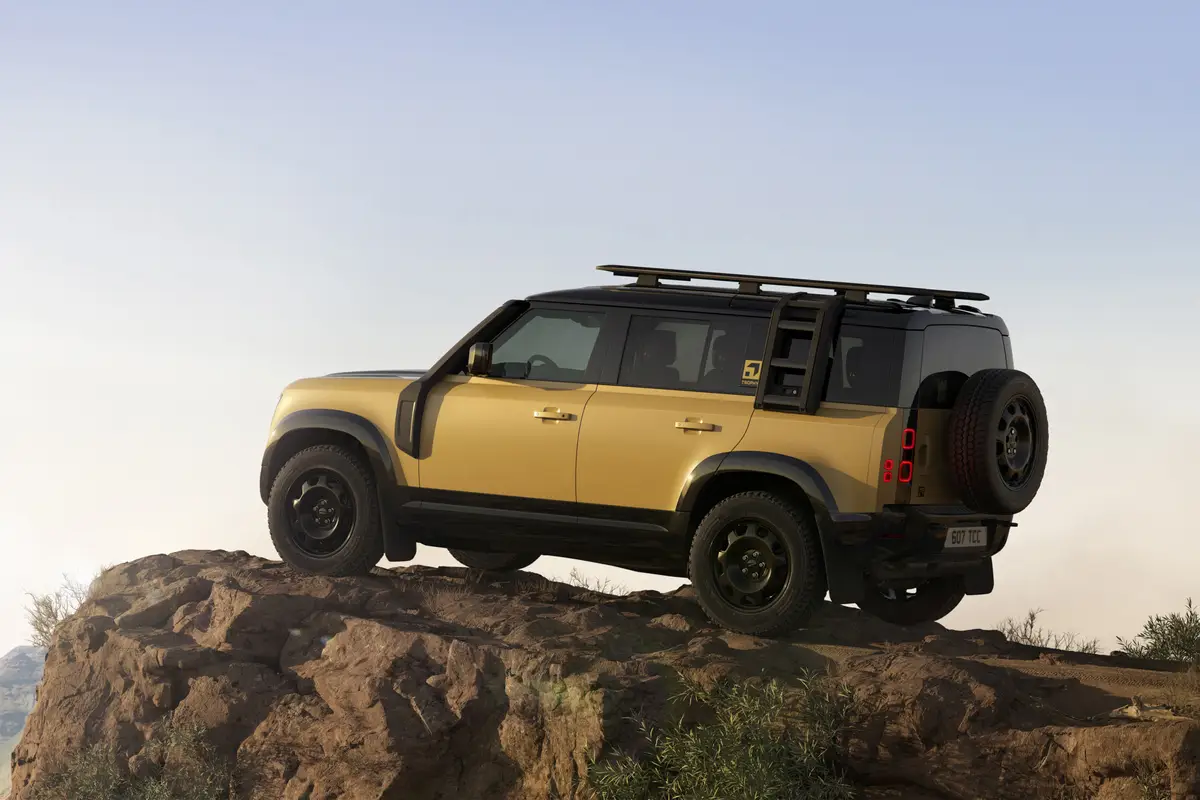chicagotribune.com's view
The last time we slipped behind the wheel of a Chevrolet Tracker it labored under the name Geo.
The Geo Tracker was a teeny-tiny, little sport-utility vehicle that boasted of high-mileage and four-wheel-drive all-season motoring, but a vehicle that went “ting” when you slammed the door and shook until it recovered from the blow.
Tracker has matured since our last visit. Gone is the Geo name, a silly moniker used to label it an import to attract those who wouldn’t walk into a domestic showroom unless there was an import there.
Geo was Japanese–designed, developed and built by Suzuki. Tracker was a version of the Suzuki Sidekick, a means for Chevy to get a subcompact sport-utility to market quickly without having to invest in the design, development and assembly of one.
At one time, Suzuki also built an even tinier and tinnier sport-utility called Samurai, which quickly faded because when you opened the door to get in, the wafer-thin vehicle would slide over toward you. Chevy never got a version of the Samurai.
For the 1999 model year, Suzuki replaced Sidekick with a vehicle called Vitara, a two-door convertible, and Grand Vitara, a four-door hardtop. The “Grand” designation also denotes that you get a V-6 engine. Two- and four-door Chevy versions are simply called Tracker and neither gets a V-6. Suzuki wouldn’t part with it out of fear that if it did, more folks would amble over to a Chevy showroom for a V-6 Tracker than would rush the doors at the Suzuki store for a V-6 Grand Vitara.
Tracker comes with a choice of two 4-cylinder engines–a 1.6-liter, developing 95 horsepower from 1998, and a 2-liter, developing 127 h.p. that’s new for 1999.
Chevy and Suzuki offer two-wheel or four-wheel-drive. The Tracker that arrived for testing was a four-door with four-wheel-drive and the peppier 2-liter 4.
With thoughts of the Geo still fresh in our mind, we opened the door and slammed it–several times.
No ting or ping, shake or shimmy. The Geo felt as if it were assembled using foil and duct tape. A wafer thin Geo Tracker let so much noise from the road filter into the cabin, you had to open the windows to get some quiet.
For 1999, Tracker is redesigned with new sheet metal and re-engineered, so flimsy has been replaced with solid. A much-needed overhaul.
Tracker is also a bit bigger. Wheelbase stays the same but length has grown by a little more than 1 inch, to 159.8 inches, while width has swelled by more than 2 inches, to 67.3 inches.
Tracker would allow even more room to roam if the cabin was another 2 inches wider. Perhaps the next generation will provide that relief. But then, Tracker is a byproduct of Suzuki, and the Japanese insist that vehicles should fit snugly around the middle.
The 2-liter 4 was fairly impressive. Decent movement from the light, though you will experience some of the typical 4-cylinder noise from under the hood that you wouldn’t with a V-6.
Publicly, Chevy folks insist th ey can do without the Suzuki V-6 because if its buyers want more power, a salesman will be glad to move them up into a Blazer.
Privately, sources say they are disappointed with the power of Suzuki’s V-6, say it’s a problem with the 4-speed automatic and insist they can make do with the 4-cylinder engines until the problem with the V-6 is solved.
When we tested the Grand Vitara (Cartalk, Sept. 20, 1998), we were a bit surprised that the 2.5-liter, 155-h.p., 24-valve V-6 wasn’t as lively as you’d expect in such a small vehicle. Should scream. It didn’t.
Can’t complain about the Tracker’s fuel economy. The 2-liter breaks the 20 m.p.g. mark in city and highway driving at 23 m.p.g./25 m.p.g. Very good mileage, considering this is a 4WD machine with 4-speed automatic.
That 4-speed, by the way, is a $1,000 option, a rather hefty price for a small SUV, don’t you think?
While the Tracker arrived for testing in mild weather with clean roads, it was parked in the driveway las t week when the skies opened and dumped a double-digit snowfall. So much snow accumulated on the roof and hood that the subcompact Tracker looked like a full-size Lincoln Navigator hiding under a white blanket.
Good time to check out the 4WD capability. Tracker comes with a transfer case and tiny lever to shift into 4WD hi or 4WD lo. With the snow over the door jamb, we opted for 4WD lo to cut a path out of the driveway and onto the road. Tracker didn’t balk or hesitate. No slipping or sliding or tires fighting for grip.
Once on the road, we shifted into 4WD hi and headed to work with stable footing all the way. The trip, however, did take a little longer than usual only because a few souls forgot that Ford Mustangs and Chevy Camaros are best left in the garage, when the weatherman says snowfall will exceed “a dusting.”
(If the boss is reading this, we arrived at the office the typical hour early, skipped lunch and, as usual, left two hours after normal departure time. But we digress.)
One annoyance with Tracker’s shift-on-the-fly (at any speed under 60 m.p.h.), however, is that the transfer-case lever is not very smooth or quick to use. It took more than a few attempts to find 4WD hi after getting out of 4WD lo. A dial or push-button activation of 4WD would be ideal, but you won’t find that more costly system in a vehicle this small.
Base price of the unit we tested was $15,935. It didn’t take much in the way of options to reach $20,000, though at $20,000 it is still a lower-cost alternative to a Toyota RAV4, which often forces you into the front-wheel-drive version to avoid a mid-$20,000 price tag.
Must-add options are anti-lock brakes at $595, though ABS should be standard in any vehicle meant to travel on lousy roads or where there are no roads; the convenience package at $730, which includes power windows/mirrors/locks and keyless entry; and rear-window wiper/washer at $125, which pays for itself in just one snow storm.
You can pass on the tilt steering wheel at $145, cruise control at $175, and roof rack at $126 and apply the savings to the ABS.
Noteworthy standard equipment on the ’99 Tracker includes a spare tire mounted low on the rear swing-out door so as not to obstruct visibility; an upgraded suspension for a smoother, less bumpy ride; more than 2-inch wider tracking for more stable road stance and better cornering; and power rack-and-pinion steering for better response to wheel input (made standard for ’99).
Also, there’s a coin holder in the lower dash; slip-out shades in the sun visors for added anti-glare protection; a handy tray in the upper dash to hold small items; an auxiliary power outlet for a phone in the center console along with a pair of cupholders; Scotchgard protection for seat fabrics; an almost three-gallon increase in fuel-tank capacity to 17 gallons; split/fold-flat rear seat backs for more cargo capacity; electric rear-window defogger; automatic exterior lamp control that, with the daytime running lamps, automatically activates the headlamps when darkness is detected; depowered air bags; remote keyless entry; cabin pollen filter when air conditioning is ordered; and rear-seat heat ducts.
>> 1999 Chevrolet Tracker 4WD Wheelbase: 97.6 inches Length: 159.8 inches Engine: 2-liter, 127-h.p. 4-cylinder Transmission: 4-speed automatic Fuel economy: 23 m.p.g. city/25 m.p.g. highway Base price: $15,935 Price as tested: $19,551. Includes $125 for rear window wiper/washer; $595 for anti-lock brakes; $175 for cruise control; $1,000 for 4-speed automatic transmission; $145 for tilt steering; $100 for radio upgrade with CD player; $126 for roof rack; $730 for convenience package with power windows/locks/mirrors and keyless entry; and $1,520 for option package No. 2 with air conditioning, electronically tuned AM/FM stereo with cassette and digital cloc k and alloy wheels. Add $360 for freight. Pluses: Redesign. More solid, when you slam the door there’s no “ting” or body shimmy. Slightly longer and wider than model it replaces. Very good fuel economy. 4WD for all-season driving. Larger 2-liter engine now offered. Lower-cost alternative to Toyota RAV4. Minuses: Isn’t $1,000 a tad steep for an automatic transmission? And why is ABS an option on a vehicle that will spend so much time on the road in bad weather? Would like smoother transfer case lever for shifting into 4WD. >>
Latest news



